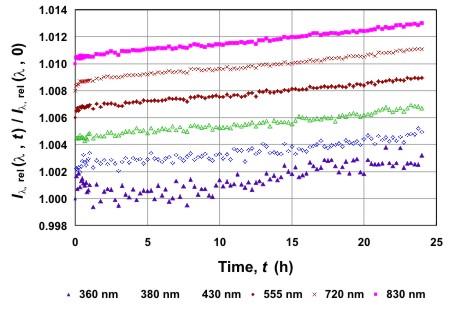Calibration and transfer standards for total spectral radiant flux
Calibration services for total spectral radiant flux:
The total spectral radiant flux (TSRF) scale (unit: W/nm) between 300 nm and 1100 nm has been realized at NIST and the calibration service is available for both NIST issued standard lamps and customer submitted test lamps (tentatively under NIST Test No. 37100S). TSRF standard lamps are used to calibrate integrating spheres using spectroradiometers (the so-called sphere-spectroradiometer systems).
The TSRF, Φλ(λ), of the test lamp was obtained in two steps: 1) measuring relative spectral radiant intensity, Iλ,rel(λ, θ, φ), of the test lamp at many viewing angles to obtain the relative total (4π-steradian-integrated) spectral radiant flux, and 2) calibrating total luminous flux, Φv, of the test lamp to determine the scale factor, kscale, to obtain the absolute TSRF. The absolute TSRF and the scale factor are given by Equation 1 and Equation 2, respectively.
$$
\Phi_{\lambda}(\lambda)
= k_{\text{scale}}
\int_{\phi=0}^{2\pi}
\int_{\theta=0}^{\pi}
I_{\lambda,\mathrm{rel}}(\lambda,\theta,\phi)\,
\sin\theta \, d\theta \, d\phi
$$
(1)
$$
k_{\text{scale}}
=
\frac{\Phi_v}
{K_m \displaystyle \int_{\lambda = 0}^{\infty} V(\lambda)
\int_{\phi=0}^{2\pi}
\int_{\theta=0}^{\pi}
I_{\lambda,\mathrm{rel}}(\lambda,\theta,\phi)\,
\sin\theta \, d\theta \, d\phi \, d\lambda}
$$
(2)
The NIST gonio-spectroradiometer is used for the measurement of Iλ,rel (λ, θ, φ) of the test lamp, and the NIST 2.5 m absolute integrating sphere, used to provide calibration services for total luminous flux, is used for the calibration of total luminous flux of the test lamp to obtain the absolute TSRF. The details of this method are described in Realization of total spectral radiant flux scale and calibration service at NIST.
NIST transfer standard for total spectral radiant flux:

An ideal transfer standard for TSRF should have uniform and smooth spectral power distribution with high correlated color temperature (CCT) covering the intended spectral range, low aging rate, uniform spatial intensity distribution, and good reproducibility. Several types of quartz tungsten halogen (QTH) lamps have been tested for use as transfer standards of the TSRF scale. Currently 75 W miniature QTH lamps are used as the transfer standards to be issued by NIST. The miniature lamp itself has a small screw base (E10), thus a special adapter for the common medium screw base socket (E26) was designed and is provided to the customer together with the lamp so that the lamp can be used in normal integrating spheres. A photograph of a 75 W standard lamp and an E26 screw base adapter is shown at the right. Other types of lamps, such as miniature halogen lamps for use in small integrating spheres for LED measurements, are being developed as transfer standards.
The CCT of the 75 W standard lamp is set to be ≈3100 K that is very close to that of the spectral irradiance standard FEL lamp, thus, measurement errors due to spectral stray light, the wavelength error, and the finite bandpass of the array spectroradiometer are mostly cancelled. The 75 W standard lamp is operated on DC power at a constant current of ≈2.9 A with ≈32 V. The required stabilization time is only 5 minutes. The figure below is the result of an aging test of a 75 W standard lamp at six wavelengths. The increasing radiant intensity with time was the effect of aging, which was a permanent change of the lamp. The aging rate was ≈0.3 % in 24 h of operation, and was very similar at different wavelengths, so the change in CCT was measured to be < 0.5 K in 24 h.
The uncertainty of the TSRF calibrations is analyzed following the international recommendation, ISO's "Guide to the expression of uncertainty in measurement" (1993) . The uncertainty of the measurement is 1.8 % to 1 % (k = 2), depending on the wavelength. The table below shows the uncertainty budget of a TSRF calibration of the 75 W, 3100 K miniature QTH transfer standard lamps.
Component | Type | Standard uncertainty (%) | |||||||
|---|---|---|---|---|---|---|---|---|---|
300 nm | 350 nm | 400 nm | 450 nm | 555 nm | 750 nm | 950 nm | 1100 nm | ||
| 1. Scaling factor, kscale, i.e., luminous flux of the test lamp (lm) | B | 0.25 | 0.25 | 0.25 | 0.25 | 0.25 | 0.25 | 0.25 | 0.25 |
| 2. Total uncertainty of the reference FEL lamp | B | 0.66 | 0.56 | 0.48 | 0.43 | 0.35 | 0.27 | 0.22 | 0.19 |
| 3. Performance of the gonio-spectroradiometer | B | 0.63 | 0.36 | 0.26 | 0.22 | 0.22 | 0.32 | 0.51 | 0.84 |
| 4. Calibration of the gonio-spectroradiometer | B | 0.91 | 0.60 | 0.34 | 0.25 | 0.25 | 0.25 | 0.33 | 0.59 |
| 5. Measurement of the test lamp | B | 0.53 | 0.52 | 0.29 | 0.25 | 0.25 | 0.25 | 0.30 | 0.39 |
| Relative combined uncertainty of total spectral radiant flux (%) |
| 1.42 | 1.07 | 0.75 | 0.64 | 0.60 | 0.60 | 0.75 | 1.14 |
| Relative expanded uncertainty (k=2) of TSRF (%) |
| 2.8 | 2.1 | 1.5 | 1.3 | 1.2 | 1.2 | 1.5 | 2.3 |
Contacts
-
(301) 975-2332

